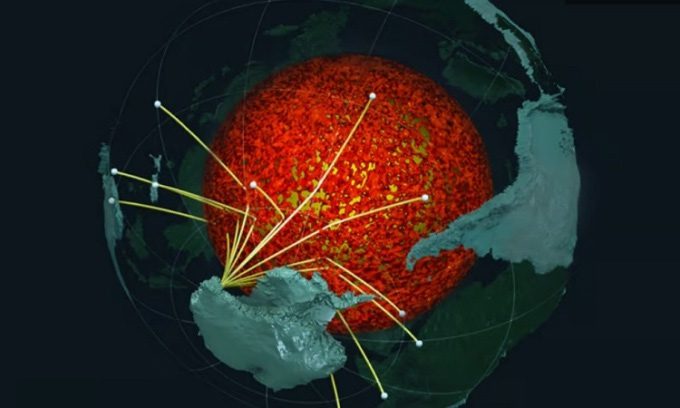Scientists Discover Ancient Ocean Floor Deep Within Earth with Mountains Five Times Taller than Everest Using Seismic Data.

Researchers collecting seismic wave data in Antarctica. (Photo: Edward Garnero & Mingming Li).
Using seismic data collected in Antarctica over the past three years, a research team concluded that millions of years ago, the ocean floor migrated toward the Earth’s core and settled as a relatively thin layer surrounding the planet’s core. The researchers indicated that this discovery could influence our understanding of how heat escapes from the core and how oceanic material can return to the surface through volcanic eruptions. They published their findings on April 5 in the journal Science Advances.
When geologist Samantha Hansen and her colleagues from the University of Alabama (UA) installed 15 seismometers in Antarctica in 2012, they aimed to use seismic waves from earthquakes around the globe to image mountains largely buried beneath the ice. While the three-year study was very successful and resulted in several publications, the data revealed unusual energy patterns appearing after seismic waves passed through the boundary between the core and the mantle (CMB). This prompted Hansen and her colleagues to conduct further investigations.
The CMB lies about 3,219 km beneath the Earth’s surface. There, the research team observed that seismic waves slowed down as they encountered a certain layer. Despite the new layer being approximately 5 to 40 km deep, it is relatively thin in terms of planetary structure. The slowdown in wave velocity in this region has led to its designation as the Ultra-Low Velocity Zone (ULVZ).
By analyzing thousands of seismic records from Antarctica, the research team’s high-resolution imaging technique identified an unusually thin material zone at the CMB at every probing point. According to Edward Garnero, a professor at the School of Earth and Space Exploration at Arizona State University, the thickness of this material varies from a few kilometers to tens of kilometers, indicating that they are observing mountains in the core, with some regions being five times taller than Mount Everest.
The way seismic waves slow down when encountering the ULVZ led the research team to conclude that it consists of material from an ancient ocean floor pushed through the Earth’s mantle over hundreds of millions of years. This is because such material is even denser than the molten rock that makes up the mantle, significantly slowing down seismic wave speeds to the extent observable in the data.
The data from the study suggests that the ULVZ could surround the entire core of the Earth. “Seismic research like ours provides the highest resolution images of the planet’s internal structure, and we find that this structure is much more complex than previously thought. The study provides important links between the shallow and deep structures of the Earth as well as the planet’s dynamic processes.”


















































